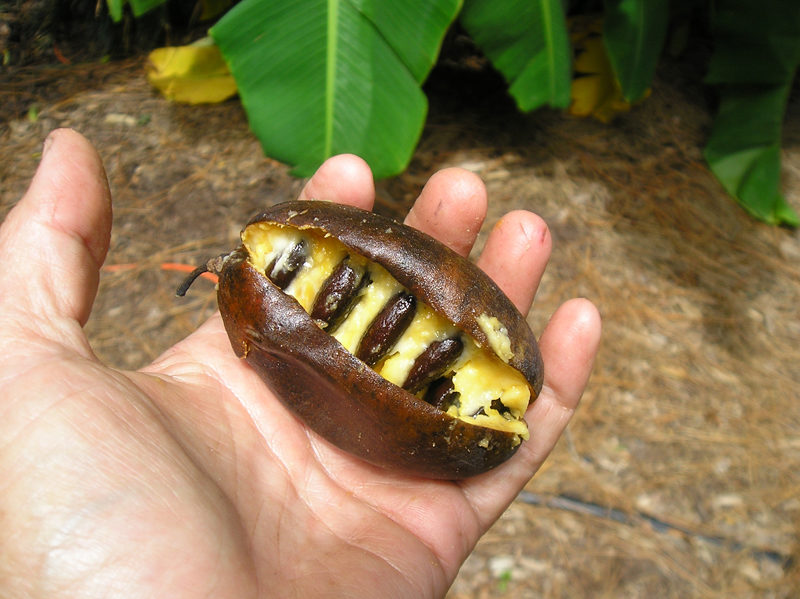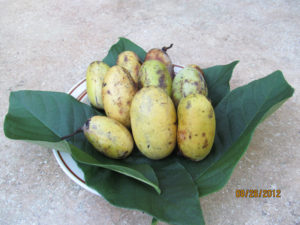 Native fruits are often a mixed bag. Tough, disease resistant, and easy to grow, but often to too small to be considered really good eats. The paw paw breaks with the norm. Known as the largest wild edible fruit in North America, it is usually found in the moist shady hardwood forests of the eastern half of the USA. The fruit has custard like texture with a rich complex combination of tropical fruit flavors. Â The flavor is often described as tasting like banana combined with mango and pineapple.Â
Native fruits are often a mixed bag. Tough, disease resistant, and easy to grow, but often to too small to be considered really good eats. The paw paw breaks with the norm. Known as the largest wild edible fruit in North America, it is usually found in the moist shady hardwood forests of the eastern half of the USA. The fruit has custard like texture with a rich complex combination of tropical fruit flavors. Â The flavor is often described as tasting like banana combined with mango and pineapple.Â
This tree is a natural for people who have yards normally thought to be too shady to grow fruit trees. It competes well with other natives trees and will eventually grow into a handsome pyramidal shaped tree. That being said paw paw are also a good fruit tree for gardeners with full sun yards. They fruit heavier when planted in the sun once mature. They do like some shade while young. It is best to give the newly planted paw paw some protection from the sun for the first two summers. Most people drape a light cover like cheese or shade cloth over the trees to get the job done.
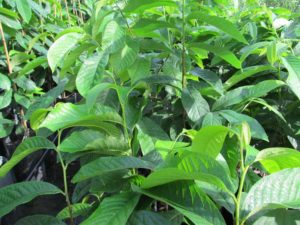 If you are looking to add an interesting fruit tree to your landscape. The paw paw is a good choice. The long broad shaped leaves are almost tropical in appearance and the tree has a beautiful pyramidal shape. Given time this tree will grow up to 20 foot and make an excellent small shade tree.
If you are looking to add an interesting fruit tree to your landscape. The paw paw is a good choice. The long broad shaped leaves are almost tropical in appearance and the tree has a beautiful pyramidal shape. Given time this tree will grow up to 20 foot and make an excellent small shade tree.
Choosing the right variety…Seedlings vary widely in flavor and can often take 4-8 years to fruit. They make excellent wild life forage and are good pollinators for the named varieties.
If you are really after the fruit, it is best to obtain a grafted tree. The grafted varieties will fruit in 2-3 years. They have larger size fruit than the seedlings and excellent flavor. Paw paw do require winter chilling to fruit well. It’s important to get a variety that is in sync with the amount of winter your area receives. The chilling requirements are between 400 and 1000 hours of chill. Many of the northern varieties will not fruit well in the deep South. Gardeners in marginal zone 9 areas need to pay close attention to getting a low chill variety for their area.
Here’s some varieties well suited for the Deep South.
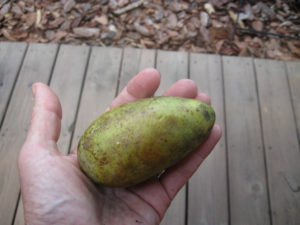 Mango Selected from the wild in Tifton, GA, by Major C. Collins in 1970. Mango paw paw is a vigorous growing pawpaw, trees can grow to 10 foot. Produces a good crop of large yellow fleshed fruit. Great candied banana flavor. Trees are grafted, usually start producing in 3-4 years. Fruit ripens late August through September. Plant with another variety of paw paw for pollination to get fruit. Zones 5-9a. Â Â
Mango Selected from the wild in Tifton, GA, by Major C. Collins in 1970. Mango paw paw is a vigorous growing pawpaw, trees can grow to 10 foot. Produces a good crop of large yellow fleshed fruit. Great candied banana flavor. Trees are grafted, usually start producing in 3-4 years. Fruit ripens late August through September. Plant with another variety of paw paw for pollination to get fruit. Zones 5-9a. Â Â
Collins Found by the late Major Collins of Tifton, Georgia. This variety has proven itself to do well in the lower South. 1/2 pound yellow fleshed variety with a rich, banana-like flavor. Great choice for folks further south and works well for up north too. Fruit ripens late August through September. These are grafted trees and usually start producing in 3-4 years. Plant with another variety of paw paw for pollination. Zones 7-9a.
Gainesville #1 Originated from Mike Duke. Mike has been testing and growing paw paws in the Gainesville, Florida area for several years. These were seedling paw paw trees that have fruited well for him. Fruit is yellow fleshed, creamy custard textured, wonderful flavor. Great choice for folks further south and works well for up north too. These are grafted trees and usually start producing in 3-4 years. Fruit ripens late August through September. Plant with another variety of paw paw for pollination. Zones 5-9A. Â
Gainesville #2 This is a second variety that has fruited well for Mike in Gainesville Florida. These trees produce a yellow flesh paw paw with excellent flavor. Fruit is mid size 3-4 inches long. Great choice for folks further south and works well for up north too. These are grafted trees and usually start producing in 3-4 years. Fruit ripens late August through September. Plant with another variety of paw paw for pollination. Zones 5-9A. Â
Sweet Potato A chance seedling from the Blandy Experimental Farm at the University of Virginia, the Sweet Potato paw paw is named for the color of its flesh. The fruit is very large, yellow fleshed and has a great, sweet flavor. Ripens August through September. These are grafted trees and usually start producing in 3-4 years. Plant with another variety of paw paw for pollination. Zones 6-8B.
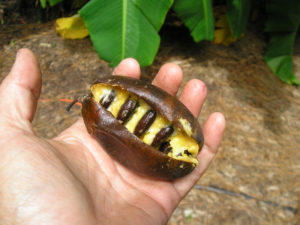 Harvesting the bounty…The fruit is harvested when it has a sweet aroma and is soft to the touch. Like bananas, paw paw will continue to ripen after you pick it. You can slow down the process by putting the fruit into the refrigerator. Be sure to put wrap each fruit with a paper towel and put in a ziplock bag to keep the fruit dry and rot free. The skin will turn brown in a week or so, this is a natural part of the ripening process and does not affect flavor. They will store for up to three weeks in the fridge. If you’d like to enjoy your paw paws year round, freeze them. They are wonderful in smoothies, mixed with yogurt or added to muffins. Really any baking recipe that lists banana or applesauce as an ingredient the paw paw can be substituted.
Harvesting the bounty…The fruit is harvested when it has a sweet aroma and is soft to the touch. Like bananas, paw paw will continue to ripen after you pick it. You can slow down the process by putting the fruit into the refrigerator. Be sure to put wrap each fruit with a paper towel and put in a ziplock bag to keep the fruit dry and rot free. The skin will turn brown in a week or so, this is a natural part of the ripening process and does not affect flavor. They will store for up to three weeks in the fridge. If you’d like to enjoy your paw paws year round, freeze them. They are wonderful in smoothies, mixed with yogurt or added to muffins. Really any baking recipe that lists banana or applesauce as an ingredient the paw paw can be substituted.
Growing paw paws are a good way to add something interesting to your landscape as well as provide a new fruit for you to share with others. They are easy to grow and a great choice for organic gardeners and permaculture food plots or edible forests.
[fblike url=”https://justfruitsandexotics.com/paw-paw-so-easy-to-grow-so-delicious/” style=”standard” showfaces=”false” width=”450″ verb=”like” font=”arial”]

